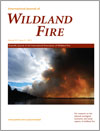International Journal of Wildland Fire
Volume 22
Number 5 2013
We modelled the distribution of wildfire ignitions across three eastern states (New Jersey, Ohio and Pennsylvania) for a 12-month period using maximum entropy. Models were parameterised with four integrated landscape variables and observed wildfires between 2000 and 2009 were used to predict the probability of fire occurrence. Monthly models performed better than a 12-month average of ignition probabilities.
We present a technique for estimating conditional probability of burn patterns for large fires. Patterns quantify the conditional probability that points near an ignition will burn and illustrate the probabilistic shape and extent of a fire. Predictive ability is good and estimated coefficients are consistent with expectations.
The El Niño–Southern Oscillation was the primary driver of historical drought and upper elevation fire occurrence, including high-severity fire, in the mixed conifer–aspen, and spruce–fir forests of the south-western US. This relationship is potentially modulated by the Atlantic and north Pacific Oceans, which could provide longer-term lead forecasting.
The WRF-Fire coupled atmosphere–fire model is used to investigate atypical wildland fire spread on steep leeward slopes. Intermittent rapid lateral fire spread is seen close to the mountain ridge line, owing to an interaction between strong pyro-convection and terrain-modified winds.
Anthropogenic burning has become a common phenomenon in pine-dominated forest ecosystems in Thailand. We investigated fuel loads and fire behaviour in a degraded pine forest and a pine–oak forest at Nam Nao National Park. Based on this study, a pine forest here requires more than 1 year of fire-free period to recover back to the pre-burn conditions.
Formulation of a physics-based model capable of predicting the spread of laboratory-scale fires is described. The model is used to investigate the importance of spatial distribution of bulk density, and of moisture content on the fire spread within a shrub.
Firebrand characteristics of untethered samples of the bark of messmate stringybark (Eucalyptus obliqua) were measured in the modified airflow of a vertical wind tunnel. The flameout and burnout times of the samples, together with the quantities of this bark available in a forest, confirm the species capability for intense spotting.
We quantified the effects of post-fire logging on forest fuel profiles as influenced by harvest intensity (percentage basal area cut) and biophysical setting (mesic to drier forests). Post-harvest fuel loads varied significantly across each of these gradients, and suggested a broadly applicable management tool relating post-fire logging intensity (basal area cut) to subsequent surface fuel loads.
This paper reports the results of laboratory experiments to test the effects on cation leaching after thermal shocks and rainfall simulations on unaltered soil samples. The amount of cations leached increased with the severity of the thermal shock; however, under moderate conditions, there was a decrease in cation leaching, mainly of monovalent ions.
Salvage logging is a widely applied post-fire management that implies the removal of nutrients in the remaining wood. We assess the value of the partially charred wood as a nutrient reservoir for the ecosystem reserves. Wood contributions were particularly relevant for N and micronutrients compared to the soil nutrient stocks.
Effects of two post-fire stabilisation techniques (grass seeding and straw mulching) on chemical properties of eroded sediments, and amount of nutrients lost with them, were evaluated. The highest concentrations of extractable base cations in the sediments occurred during the first 3 months after fire. Post-fire mulching application can be effective for reducing nutrient loss with sediments.
Traditional remote sensing approaches to assess fire severity provide information for post-fire management; however, they do not provide a useful approach to adjust combustion completeness (CC) and carbon emissions. We show a remotely sensed approach that provides a measure of fire severity that can be used to refine carbon emissions.




